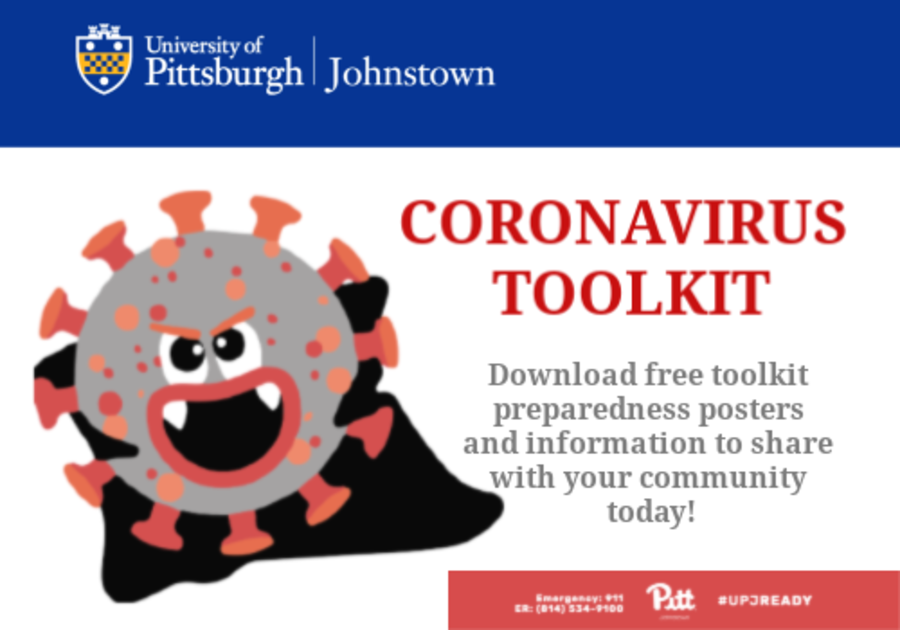I just got off the phone with a friend and we were discussing-what else-the Coronavirus or Covid-19. She asked if I followed one of her friends on Facebook who was an expert on this subject. No, I didn't. She tagged me in the most recent post and I immediately sent a friend request and was accepted.
A few minutes later I was on the phone with Jill Henning, Associate Professor of Biology at University of Pittsburgh at Johnstown. I wanted to know more and she was all too generous with her time.
She directed me to the Coronavirus ToolKit that she and a team had put together for the community and gave me permission to share with you. They started working on it in February because as she explained, '"they saw it coming". It can be applied to any infectious disease.
First, I want to share her Facebook Post that explained so well the importance of social distancing and the need for testing.
"March 29, 10:42 AM
Stay home, stay safe
Here are some common questions that I have been asked lately:
Please stay home, there are four basic phases to an epidemic (pandemic).
The first is early ascending where the previously unidentified emerging infectious disease is in a few individuals and those they have come into contact with.
Movement to the next phase of the epidemic depends on transmission. COVID-19 is droplet, airborne, and fomite transmission (coughing, sneezing and touching things that those droplets have landed on). With airborne transmission we see movement to the exponential phase very quickly, but this phase has sub phases to it. There is a slow lag followed by a dramatic increase in cases. This WILL last as long as individuals continue to gather in groups in the community (social distancing slows this phase and flattens the curve).
Next comes a stationary phase where number of new cases will equal the number of recovered cases.
Finally, we will see an early descending phase followed by endemic levels of cases or no cases. So, what does all of this mean? Sit tight we are going to be here for a spell. If more testing was available, we could work to decrease the number of cases, but it is my understanding that testing is not available or not being done. You should be upset about that. Testing can help flatten the curve.
COVID-19 has a lipid membrane around it like human cells do. It is also an RNA virus. The lipid membrane is less likely to remain intact in higher temperatures and lower humidity. Think butter in the fridge vs in the microwave. The RNA genome makes it susceptible to UV radiation. So, it is hypothesized that when it gets warmer the virus will not last as long in the air. Bring on the sunshine.
Convalescent serum is currently being tested as a treatment for those in an active infection. When a person has an active immune response to an infection, meaning they got the infection naturally and produced a specific response to it, they will have high levels of antibodies for 6 months and low levels for about 15-20 years.
Present data says that the virus is not experiencing antigenic shift (when RNA segments of the genome are swapped, like in Bird Flu or Swine Flu) but it is undergoing antigenic drift, the point mutations that result in changes in proteins that allow the virus to bind to our cells. So with that data, it seems that we will have COVID-19 for a while, but it may not be a Pandemic again. We can make a vaccine and protect against it, like we do with Influenza B.
If you have to go to a public place (like the grocery store or to work), it is a good idea to wash your clothes as soon as you come home and take a shower. With airborne droplet transmission, the virus can be on your clothes. If you can’t wash your clothes, try putting them in the dryer for 20 mins on high heat."
GET YOUR UPJ CORONAVIRUS TOOLKIT HERE
 | Thank you to Jill Henning for sharing this information with us. Jill D. Henning, PhD is an Associate Professor of Biology at the University of Pittsburgh Johnstown Campus. She has a broad background in immunology, infectious diseases, and cancer biology. In general, her research examines how infectious disease affect humans and animals—a concept referred to as “One Health.” She has divided her research into two specific categories: viral influences on immune function associated with cancer and zoonotic infectious diseases and their vectors. She completed her Ph.D. in Infectious Diseases Microbiology from the University of Pittsburgh’s Graduate School of Public Health in 2008. She was a post-doctoral fellow in biobehavioral medicine for a year and joined the faculty at Pitt-Johnstown in 2009. She teaches Immunology, Microbiology, Ecology of Infectious Diseases, Medical Microbiology, Anatomy and Physiology and Life Sciences. |
TOP TRENDING SEARCHES |
 EVENTS EVENTS |
🌸 Macaroni Kid Johnstown/Laurel Highlands/Altoona is a free weekly e-newsletter and website that highlights all of the great things for kids and their families to do in the community. Plus, you can find fun activities, family-focused businesses, book and product reviews, recipes, crafts, and much more! Macaroni Kid Johnstown/Laurel Highlands/Altoona serves families in Johnstown, Ligonier, Ebensburg, Hollidaysburg, Altoona and other surrounding communities.
FOLLOW US |
 |  |  |  |  |  |





